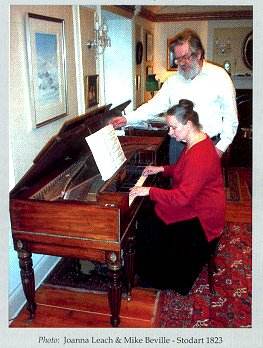Comparison Recordings
of keyboard music by Haydn:
Hob XVII:1, 7; Derek Adlam, clavichord
Guild GMCD 7260
Sonata in D, Hob XVI: 49, Hob XVI: 51:
Glenn Gould, piano CBS M2k 36947
Sonata in D, Hob XVI: 51: András
Schiff Warner Elatus 2564 60807-2
Variations, Hob XVII:6 & 7. Ronald
Brautigam BIS CD-1324
Leach plays three square
grand pianos on these recordings, one
of which has just the suggestion of
a slight buzz in the low bass. Otherwise
they are all very sweet sounding with
a clean high and middle register, certainly
sweeter sounding than Brautigam’s fortepiano,
but every bit as supple. Compared to
a baby grand piano the sounding board
on a square grand is wider but smaller
in area, and the strings are arranged
nearly parallel to the keyboard so the
instrument can sit close to a wall.
Generally the bass strings are a little
longer than on a baby grand, rather
like those on an upright spinet. These
instruments have essentially modern
action and pedals, but due to restricted
space in the case, a square grand is
relatively difficult to work on so very
few square grand pianos are currently
in playing condition although at one
time they were very popular. I was privileged
to play the square grand at the Shepard
museum in San Diego, California, and
was as charmed by the beautiful tone
as I was by the attractive wood case.
Listened to from across
a room, these pianos are quieter in
sound than a modern piano; however,
with the lid up, directing the sound
right at the player, the player would
experience a sound at least as loud
as on a baby grand piano, and these
sonatas were written more to be played
personally than to be heard in concert,
where, in any case, large instruments
would have been available. Therefore,
miniaturizing the sound of this music
is in my mind a mistake and this performer
gives us a strongly projected interpretation.
Leach plays cleanly
and affectingly, but with less drama
or imagination than Schiff, less sensuality
than Ax, and with all the clarity and
brilliance, but a little more heart
than Brautigam. Adlam’s performance
on his own copy of a clavichord of Haydn’s
time effectively explores that instrument’s
capabilities with imagination and verve.
But since neither his instrument nor
his technique explore the earlier clavichords’
legendary ability to produce a fluid
singing line, one would mostly rather
hear this music on a piano.
Leach brings out the
similarity in style between Haydn and
Schubert in Sonata #51, and I would
like to hear her play Schubert. Schiff
plays this same sonata with a more Beethovenian
sense of drama, and a little more verve;
clearly he is a more secure artist,
but the music is served extremely well
by both performers. Gould’s playing
is tyically very staccato and crisp,
with his customary and unique kind of
energy, and just the suggestion of his
usual singing along in the background.
It is to Leach’s credit that there is
no wide gulf between her playing and
these fixtures of the modern virtuoso
stage; they could all learn a little
something from each other.
Paul Shoemaker
see also reviews
by David Wright ATH
CD2 Kirk
McElhearn ATH CD22
The
Divine Art
Athene
Minerva now distributed by The Divine
Art


